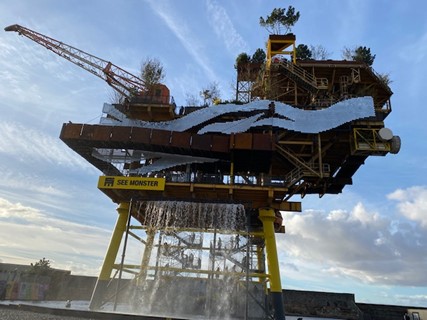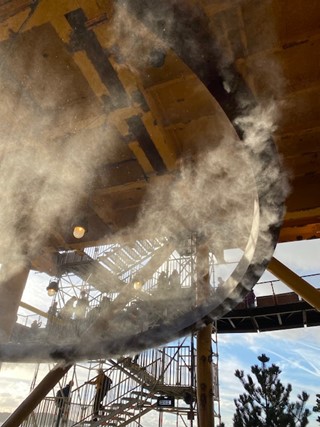Billed as an ‘extraordinary act of collective creativity’, and one of ten projects which form part of the controversial Unboxed: Creativity in the UK, SEE MONSTER is conceived as a fusion of environmentalism, creativity, fantasy, and play. Standing 35 meters tall and weighing in at 450 tonnes SEE MONSTER sits in a shallow pool at the former Tropicana lido on the beach at Weston-Super-Mare on the west coast of England. Its bones are a de-commissioned North Sea gas platform. Its purpose is to provide a temporary art exhibition and high-rise garden designed to inspire conversations about the climate emergency, renewable energy, and sustainability.

See Monster seems at first to be disconnected from its environmental origins; beached at the Weston-Super-Mare seabreak like a poorly navigating whale, lumpen but silent, one decapitated head of an extensive infrastructure of gas pipelines, container ships, and sea-blasted steel.
There seems nothing to be learnt here, neither of energy nor extraction, nothing to be taken away about either environment or ecology except the banal reiteration of the perils of reliance on the very things it was built to serve.
Yet See Monster does speak through other forms – the forms of those who come to see it, climb it, stomp around it, grab hold of it, or skelter downwards through it. And it speaks also through other sounds, too: the sound of the waterfall which roars down into a pool at its feet and the sound of the wind through the sculptures of its topmost deck. What role does sound play, then, in viewing the See Monster – first on the bodies of those who immerse themselves in it, and second of the sounds it makes itself.
While understanding more of environment might seem absent in cerebral terms it is clearly felt by visitors in physiological ones. See Monster’s vertiginous rise from the ground floods through the nervous system, snapping into the fizz of nerve-endings well-known to those with a fear of heights. The steep metal stairways and swaying cantilevered walkways increase respiration and make muscles work. By the top deck the wind whips around the face and demands attention to balance. Its sound makes for shouting, and for breathlessness. The quickest route down, by a narrow slide, reminds us of weight and movement. Energies kinetic, thermal and electric emerge from everyone enwrapped in See Monster’s structures.
There is something alchemical in its power to make us feel those energies in place of the energy it has itself lost. It makes us remember that the most generous and critical understanding of energy must include those human physiological energies underpinned and maintained by those other energies it once helped to extract.
As well as the sounds one’s own body makes, the See Monster also provides its own noise. The monster’s roar comes from the waterfall which pours from the first deck into a pool below.

Its first deck uses the old gas distribution pipes to emit a vaporous steam – the monster’s breath, possibly – which hisses across visitor’s heads.

On the top deck a wind sculpture captures the winds blowing in across the Severn estuary and transforms them into a low consistent droning shriek.
The effect of the sound is to give the See Monster some form of life – or at least the effect of aliveness. It also acts to remind us, through sound, of the cost to the environment, of energy extraction. The sounds are all sounds associated with pain and stress – the roar, the hiss, the shriek. Combined with the sounds we experience from within our own bodies there is a growing See Monster soundscape that speaks to energy, our efforts to get it and use it, and the damage to the environment that it can do.
The See Monster is not the monster it once was. It is instead another kind of beast; transformed into immersive art where the very mode of immersion constitutes the method by which understanding and reflection can begin. Ironically, it is not what one sees of the See Monster that counts. It is what one hears and feels.
UPDATE: In November 2022 the exhibition of the SEE MONSTER ended, the structure was dismantled, and its parts recycled. It is still possible to visit the monster online, take an audio tour or listen to the immersive audio experience Weathering Together.
Martin Willis

